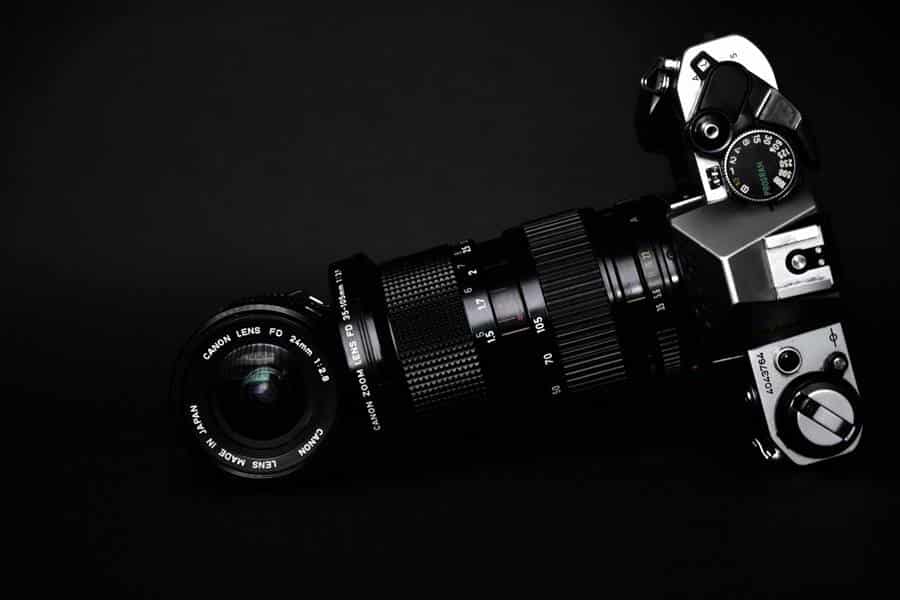In 2015, the legendary German manufacturer ZEISS introduced six lenses to the photographic world, thus opening the new Milvus line. Five more lenses were announced over the next few years. The ZEISS Milvus line now includes 11 lens models.
These lenses are designed for Canon EF, and Nikon F mounts. Without exception, all have manual focus and fixed focal length. Today, our review is not a novelty because our selected lens was announced five years ago, but it does not lose its relevance and competitiveness. Moreover, with the advent of Canon and Nikon full-frame mirrorless cameras, manual lenses have become much easier to work with. So welcome – the ZEISS Milvus 2/100M macro lens review.
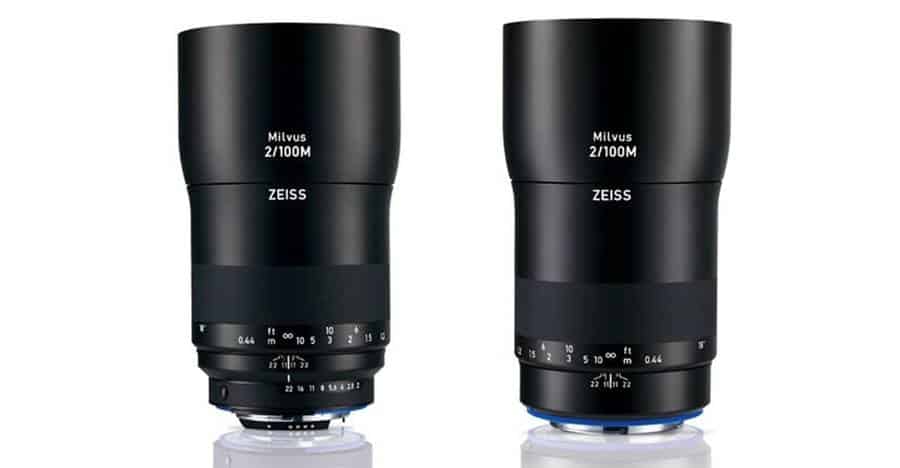
The lens has a recognizable appearance. And it will be incredibly familiar if you’ve read my reviews of the Batis line. However, this style was not borrowed from Batis but the ZEISS Otus line. It has a modern, streamlined design, a whole metal body, and a rubberized focus ring. The materials, assembly, and design of the ZEISS Milvus 100/2M are delightful. Starting with the packaging, you can feel premium.
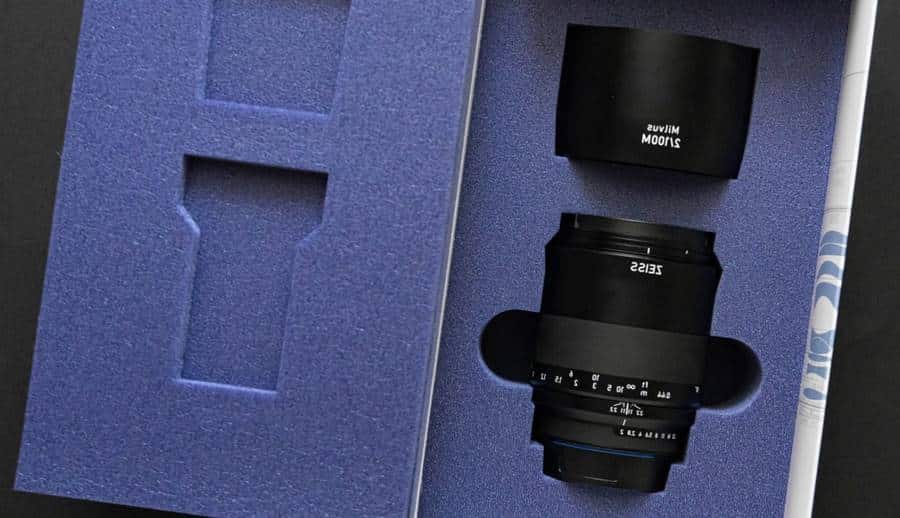
ZEISS Milvus 2/100M is made entirely of metal and quite thick metal, as I already wrote. The conical hood included in the kit is also metal; the inner part is covered with a flocking method, which prevents re-reflections.
The hood is quite deep, which is suitable for protecting against glare, but it creates certain inconveniences in working with filters, for which position adjustment is essential.
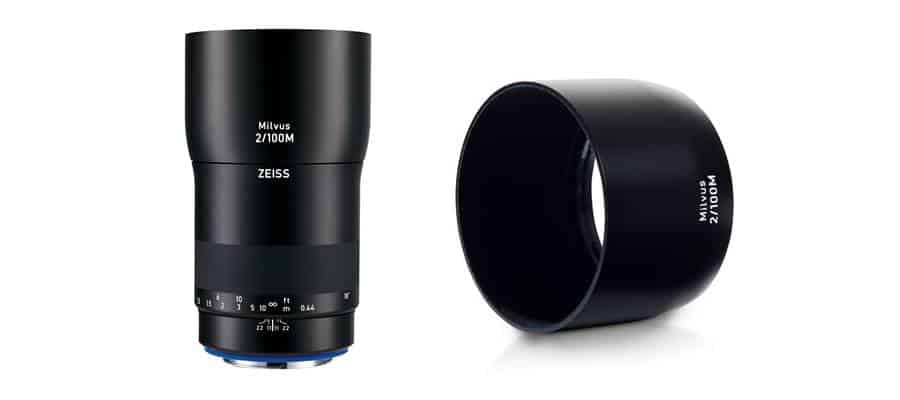
The lens barrel is waterproof and dustproof, and the mount has a proprietary blue rubber gasket.
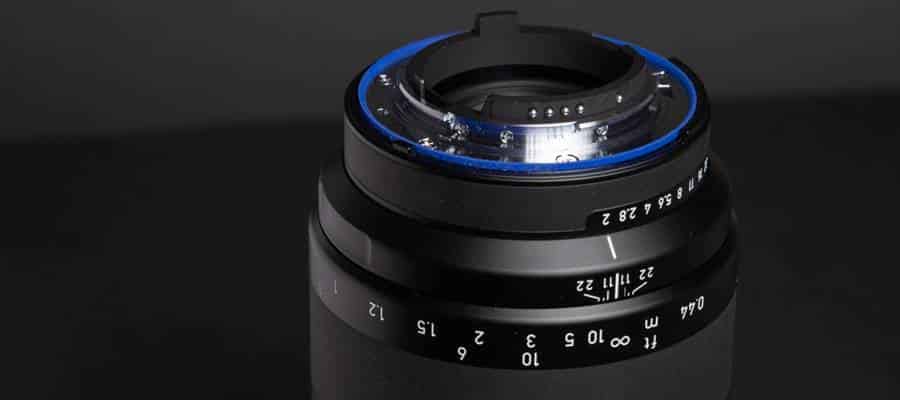
All inscriptions and markings are engraved. There is a guide to the focal length and depth of field for the f/11-22 range.
The Canon EF and Nikon F versions are different. The Nikon version has separate aperture control, which is incredibly convenient. Additionally, a so-called de-click function allows you to adjust the aperture smoothly, not in jumps, which is very useful for videographers.
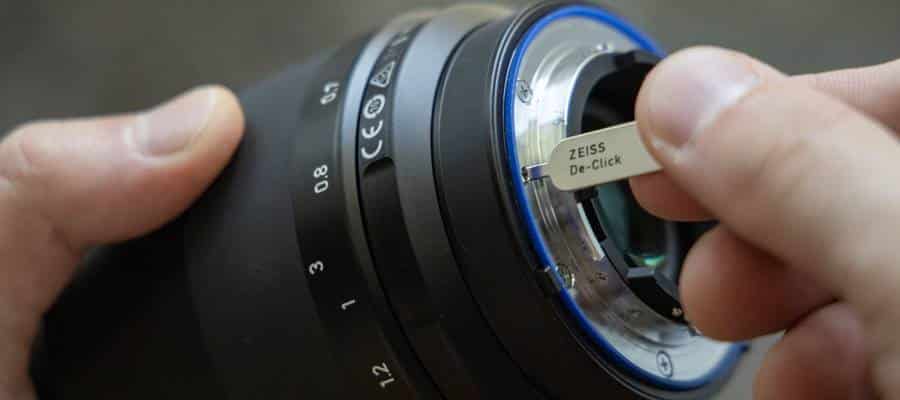
The kit contains a key that needs to turn a unique lock on the bayonet mount to enable smooth adjustment.
However, Nikon Z owners will have to forget about manual lens aperture switching and the de-click function. Control is possible only through the camera. When first powered on, the camera will beep to set the lens aperture to F/22. By the way, the ZEISS Milvus 100/2M lens has a lock that works when the aperture is set to f/22, which will prevent accidental switching.
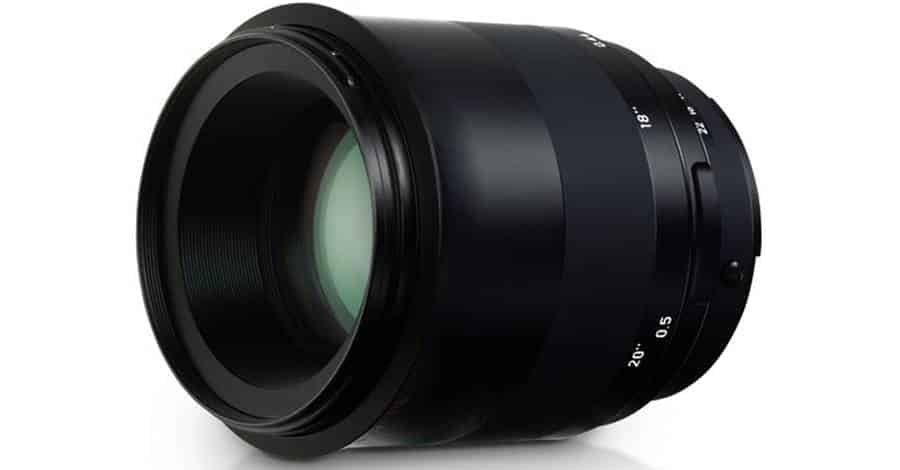
The focus ring takes up almost the entire body of the lens, which, in turn, creates inconvenience when attaching or removing the lens from the camera. You have to hold the lens by the base at the mount, and there is not much space.
However, there were no inconveniences; since testing was carried out on a Nikon Z6, I removed the lens together with the FTZ adapter simply because of all my other Nikkor Z lenses. The camera protects the bayonet mount.
Only a part of the focusing ring is rubberized. I must say that, at first glance, it is better than that of the Batis line. Dust, unlike the named line, does not stick to it, even after a long time of work. However, let’s see how it shows itself months later.

ZEISS Milvus 2/100M Lens Specifications
The ZEISS Milvus 2/100M does not have the largest folded dimensions when compared to its counterparts. The minimum length is 103mm, and the maximum (in macro position) is 198mm. Objective diameter 81mm.
The closest Nikon system is a 105/2.8 macro lens, 116mm folded in length and 83mm in diameter. But the weight of our Zeiss lens is the largest among analogs – 843 grams, the materials of manufacture effect. Filter diameter 67mm.
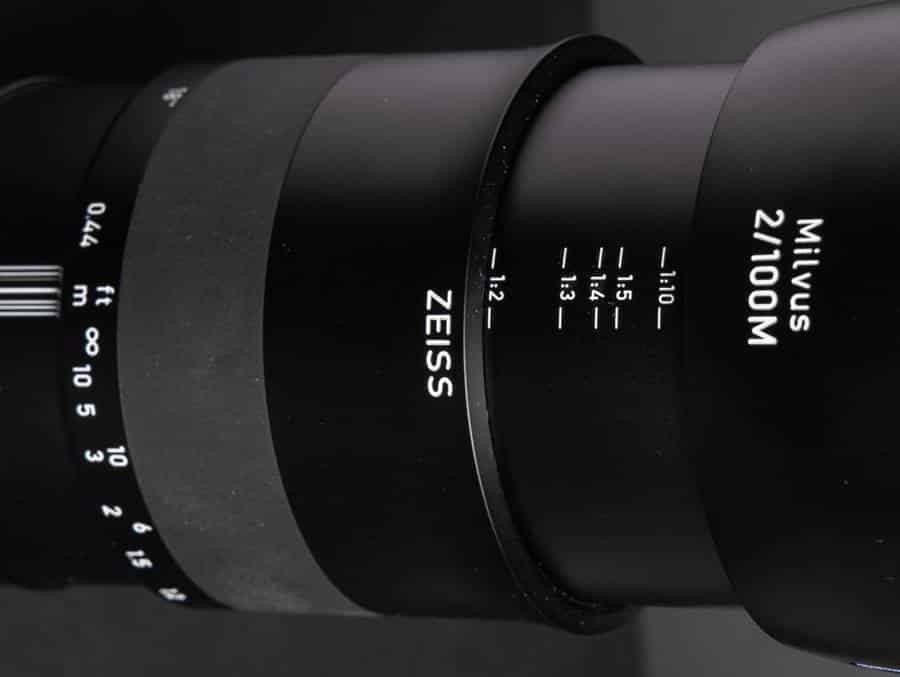
As you can see, when focusing, the lens enlarges significantly. The advantage of the sliding design is that the lens is compact when folded. Lenses that do not change size when focusing are much more significant.
The minimum focusing distance is 44mm, which corresponds to a ratio of 1:2. Perhaps this is the first minus that should be mentioned. After all, all macro lenses with the same focal length give a 1:1 scale. However, all analogs have an aperture rate one-stop lower, that is, f/2.8.
A shallow depth of field of f/2, combined with telephoto focal length and even this ratio, can more effectively isolate the subject even from distracting backgrounds or create artistic blur. This effect will be more challenging to achieve on analogs with an aperture of f/2.8.
Nevertheless, suppose you need a larger scale. In that case, there is a decision in the form of purchasing a proprietary Nikon 1.4x or 2x converter, which, in turn, will increase the scale to 1:1.4 or 1:1, respectively. Still, you will have to sacrifice the aperture ratio.
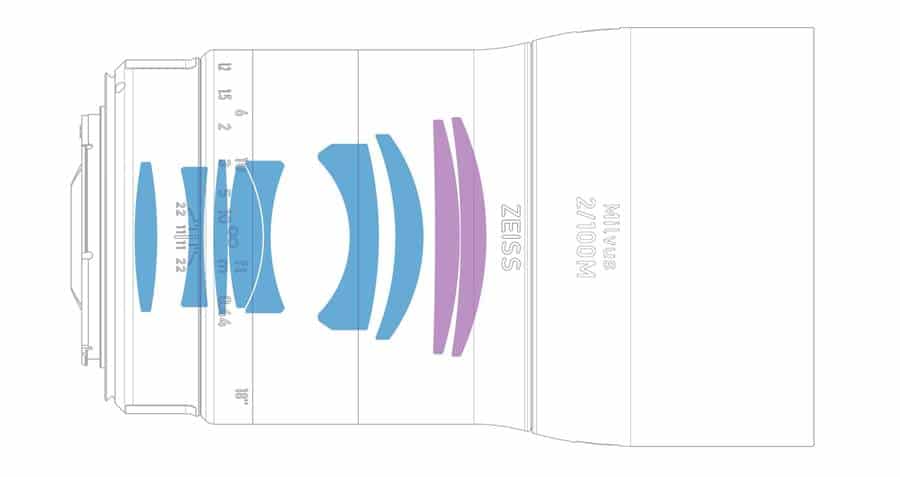
The diaphragm consists of 9 rounded blades. The ZEISS Milvus 2/100M optical design is entirely consistent with its predecessor, the ZEISS 100mm f/2.0 Makro-Classic. The lens consists of 9 elements in 8 groups, and the optical design contains two EDG elements, a floating element design. Some lenses have our signature T* anti-reflective coating, as evidenced by the lettering on the lens.
The novelty has received updated housing with protection against moisture and dust penetration and a new optical coating compared to the first version. However, the owner of the Classic version should hardly consider upgrading.
You may also like to read: Macro Lenses: Canon 100mm f/2.8 Macro USM VS Tamron 90mm f/2.8 DI Macro.
ZEISS Milvus 2/100M Specification Summary
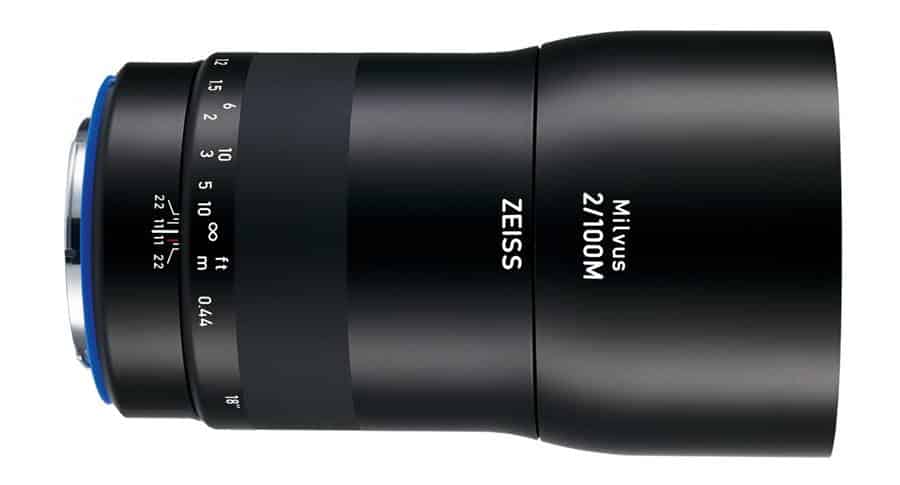
| Focal Length | 100 mm |
| Optical Stabilization | No |
| Bayonet | Canon EF, Nikon F (FX) |
| Maximum Aperture | F2 |
| Minimum Aperture | F22 |
| Optical Design | 9 Elements in 8 Groups |
| Special Elements, Coating | 2 APD Elements, T* Enlightenment |
| MDF | 0.44 m |
| Maximum Magnification | 0.5x |
| Autofocus | No |
| Weight | 843 gram |
| Diameter | 81 mm |
| Length | 104 mm |
| Sealing | Yes |
| Filter Diameter | 67 mm |
ZEISS Milvus 2/100M Ground Test & Review
Before starting our tests, I would like to clarify a little about manual focusing with the ZEISS Milvus 2/100M. The movement of the lens focusing ring is moderately and has a comfortable resistance, and a full rotation from the minimum distance to infinity is almost 360 degrees. It allows you to fine-tune the precise focus very fine.
I recommend focusing on the lowest sensitivity and using electronic zoom whenever possible for maximum ease of use. In this regard, mirrorless cameras outperform DSLR cameras. Of course, DSLRs in the viewfinder have an assistant in the form of an LED that lights up when the focus is correct, but it still has a specific error.
Live View can be used with maximum electronic zoom for more precise focus, but this method is not applicable in all situations.
Sharpness

As usual, let’s start our tests with the most important metric – lens sharpness. More than ever, this indicator is crucial because we are dealing with a macro lens. For the first test, we will use our standard test world.
The lens shows incredible sharpness, which practically does not change from the center to the periphery of the frame. Around f/16, you will notice a slight softening of the image across the entire frame due to diffraction. Further aperture gradually reduces the sharpness; however, the picture is still acceptable.
Now let’s test the sharpness of the lens at its minimum focusing distance.

At the minimum distance, we can also observe uniform sharpness across the entire field of the frame; however, at f/2.8-3.6, the sharpness is slightly lower. But starting from f/4, there is a ringing sharpness, which continues until about f/11-13, the picture softens. So the recommended aperture range for maximum sharpness is f/4-11.
Chromatic Aberration
Let’s examine the lens for the manifestation of two types of chromatic aberrations – longitudinal and transverse. Longitudinal aberrations appear only at open apertures. Below is the ZEISS Milvus 2/100M test on the DataColor SpyderLENSCAL calibration target.

At f/2.0-4, longitudinal aberrations of violet (foreground) and green (background) appear, which disappear entirely at approximately f/5.6. Longitudinal CA is quite noticeable at open apertures, which leads to similar results when shooting contrasting details.
It would help if you were prepared for this. So if there are high-contrast details in the frame, either cover the aperture or mentally prepare for processing in the RAW converter.
Now let’s check the lens for lateral chromatic aberrations. These aberrations appear at all apertures and are usually closer to the periphery of the frame.
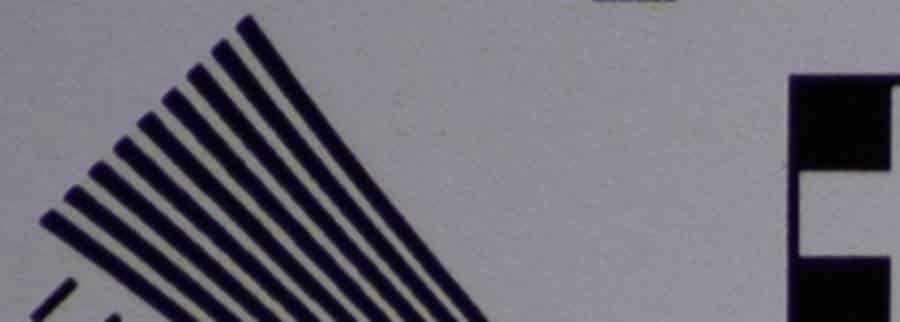
The lateral XA is not typical for the ZEISS Milvus 2/100M. A perfect indicator.
Distortion
There is nothing to say here – perfect geometry.
Vignetting
At the widest aperture, vignetting is negligible. Starting at f/5.6, the vignette effect at the corners of the frame disappears completely.
Glare Protection
As already mentioned above, our selected lens is equipped with a deep cone-shaped hood with a light-absorbing coating inside. It must be said that even without the use of a hood, the lens is not subject to flare. By deliberately finding the angle at which the highlights appear as much as possible, I was able to get the following result.
When the backlight hits the frame, the picture practically does not lose contrast – a perfect indicator.
Bokeh
The 100mm focal length is perfect for portraits. However, while autofocus is utterly optional for macro photography, the lack of autofocus introduces certain limitations for portrait photography. However, let’s analyze the lens drawing in the out-of-focus area.

At its widest aperture, ZEISS Milvus 2/100M shows superb bokeh – in the center of the frame, the discs have a perfect circle shape, and closer to the periphery, shape distortion is minimal. The filling is uniform, and the edges of the discs have practically no rim. When the aperture is closed, the discs acquire the shape of a nine-sided shape and ultimately retain this shape throughout the entire field of the frame.
Breathing Focus

Alas, there are no perfect lenses. If almost all the previous tests were passed perfectly, then here we will be disappointed. When you change the distance from minimum to infinity, the scale is reduced by as much as 44 percent.
I have not yet met the worst indicator. Nevertheless, I successfully used the ZEISS Milvus 2/100M for subject video shooting, but I must say that the focus remained fixed.
But if you twist the focus while filming, the result may not be very acceptable. It is how it looks when changing the distance from minimum to infinity.
Photo Gallery ZEISS Milvus 2/100M
Conclusion
The ZEISS Milvus 2/100M has not unique characteristics but also impressive optical properties. Incredible sharpness, precise geometry, minimal vignetting, excellent glare protection, and just perfect bokeh. But, of course, there are also disadvantages.
Alas, chromatic aberration on high-contrast objects is visible to the naked eye. As for the massive breathing of focus, this is a minus for videographers and photographers using the focusing technique. And also, a minus can be considered an increase of 1:2, but I must say that this is quite enough in most situations.
Many will say that the main disadvantage of this lens is the lack of autofocus. Autofocus for macro photography is not an essential thing; moreover, as a rule, manual focus is used by photographers for macro photography. The focal length of 100mm is also applicable for landscapes, and here, autofocus is also not so necessary.
The only place where difficulties can arise is portrait photography if the model is actively moving and you shoot at the widest aperture. So do not be afraid of manual focus, especially when working with mirrorless cameras, where convenient focusing is available.
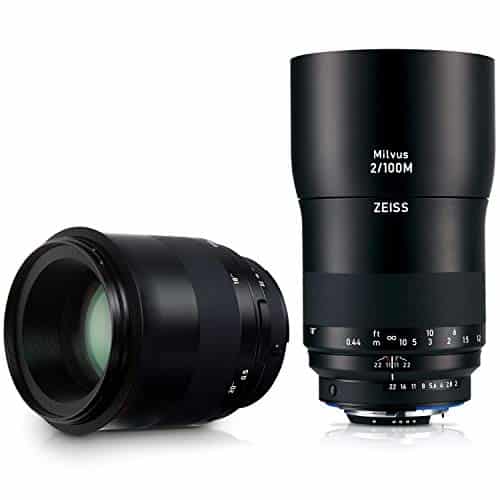
There are no analogs of ZEISS Milvus 2/100M at the moment. Perhaps soon, we will already see macro lenses for the RF and Z baronets with the same focal length and aperture but autofocus.
I assume that these lenses will cost a little or even a lot more than our hero. But today, we can safely say that the ZEISS Milvus 2/100M is the best macro lens with a focal length of 100mm.









